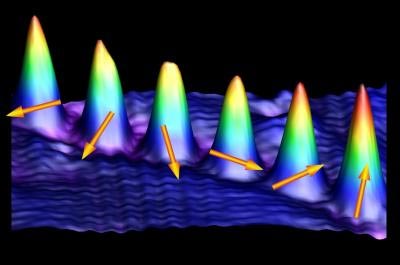First Image Made of an Atom Spinning

Physicists have discovered a way to play with matter on a subatomic scale, reaching into atoms to manipulate the spin of electrons. What's more, the scientists were able to capture the first images of the action with a special microscope.
Spin is one of three basic properties of electrons, along with charge and mass. Basically, spin describes an electron's angular momentum, which is related to the way an electron moves around an atom's nucleus (which includes the protons and neutrons) – the spin can either be "up" or "down."
In the new study, researchers figured out how to change the spin of electrons in cobalt atoms (a metallic element with 27 protons and 27 electrons). They used a custom-built microscope with a minute iron-coated tip to "see" the atoms and create the first images of electron spin being manipulated.
On scales this small, it's impossible to take a picture using visible light, as the wavelengths are bigger than the objects they would reflect off of. But a technique called scanning tunneling microscopy allows physicists to feel what's going on, kind of like a blind person reading Braille, said study leader Andre Kubetzka of Germany's University of Hamburg. The very tip of the special microscope is thought to be only a single atom wide.
To change the spin of the electrons in the cobalt atoms, Kubetzka and colleagues placed the atoms on a surface made of the element manganese. The manganese was arranged so that its electrons' spins varied in a spiral pattern. When the physicists shifted the cobalt atoms on top of this spiral, the spins of the electrons shifted in order to align with the spin of the electrons beneath them. Thus the scientists could observe an atom moving from a position where its electrons were spin up to spin down.
"By precisely positioning the cobalt atoms on the manganese surface, we can tune the spin-direction of the cobalt atoms," said co-researcher Saw-Wai Hla of Ohio University's Nanoscale and Quantum Phenomena Institute.
In the microscope's images, when an atom's net spin was up, the atom appeared as a single protrusion, but when its spin was down, the atom looked like a double protrusion with two peaks of equal heights.
Sign up for the Live Science daily newsletter now
Get the world’s most fascinating discoveries delivered straight to your inbox.
"The shape is different – this was a surprise," Kubetzka told LiveScience. The scientists think these different shapes result from the electrons traveling in different orbitals, or patterns around the nucleus, depending on their spins.
The study could lead to high-tech applications down the road, the scientists said. There is an emerging field of electronics called spintronics that aims to build faster, smaller and more efficient computers by manipulating atomic spin. Spin up and spin down could represent the two options in a binary code.
"Different directions in spin can mean different states for data storage," Hla said. "The memory devices of current computers involve tens of thousands of atoms. In the future, we may be able to use one atom and change the power of the computer by the thousands."
However, those applications will take some time, because the current experiment was conducted in a vacuum at super-chilled temperatures. To make computer hard drives, the process would need to be heated up to room temperature, which would be difficult because the warmer atoms would hop around and be much less stable.
- Twisted Physics: 7 Recent Mind-Blowing Findings
- Album - Behind the Scenes at the Largest U.S. Atom Smasher
- Quest Aims to Create Bigger Atoms and New Kinds of Matter











